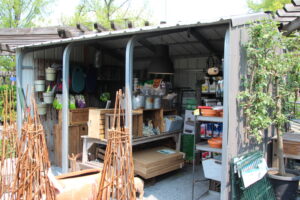A Fresh Start
For many in our industry, 2007 presented more than its fair share of challenges, from the unpredictable environment to a shaky economy. But when we asked these six industry leaders two garden center owners and four professionals in horticulture and retail to offer their predictions for the next 12 months, the outlook was mostly sunny, with the storm clouds of the past year already beginning to clear.
The shadows of those clouds will stick around, but they’ll be in the form of lessons learned for the coming year, opportunities to help us be more mindful of similar challenges in the future. Read on for our panelists’ predictions.
Balance Sustainability with Practicality
Emily Stefanski, University of Florida, [email protected]

With sustainability on the forefront for 2008, I think our industry is well on the way to finding solutions on how to implement sustainable practices both in the products produced and within the businesses themselves, such as the use of biodegradable pots, plastic recycling programs, renewable energy and green roofs. If we are viewed as the innovators and early adopters of sustainability, that will only further promote our products, especially to younger consumer groups who have a more vested interest in preserving our current standard of living to future generations.
However, be cautious on the retail products that you promote to your customers. All the hype of sustainability and “going green” does not automatically translate to selling all organic products. There is no doubt that the organic option is a growing trend, but the organic products you sell still have to satisfy the customers by producing effective results. Be sure to trial your organic products first with your employees and customers to know whether you can confidently promote them and what the customers’ expectations should be.
Another up-and-coming trend is shopping and buying local. This is starting to be a great option for people who are “going green” fewer products needing to be shipped long distances or even globally saves on energy. Plus, people are justifying the higher prices more with local establishments because the quality is generally better and the money stays within their community. Great news for independent garden centers!
Finally, continue to promote and direct educational efforts toward Generations X and Y. With the baby boomer generation approaching retirement within the next 10 years, their discretionary income may be put toward downgrading the house (and yard) and invested in more getaways and not spending as much on gardening activities. Prepare now for this future scenario by putting together focus groups composed of younger generations, employ a work force that is made up more of the younger age groups thereby creating a young, hip culture in your business and start using technology that new generations are accustomed to (blogs, podcasts, social networking sites and YouTube). Best wishes in 2008!
Maintain Relevance in a Changing World with Evolving Needs
Dale L. Bachman, Bachman’s, Inc., [email protected]

There are some major trends that will continue to affect the business climate during 2008. The lawn and garden industry is reaching maturity in the business cycle. Younger homeowners between the ages of 25 and 40 have vastly different attitudes about gardening. For many consumers, the locally owned garden center is the preferred destination for expertise to achieve a desired end result. For younger homeowners, the value proposition of the locally owned garden center is less understood. At Bachman’s, our challenge is to stay fresh and be a source for inspiration, ideas and expertise. We provide trendsetting products and services that will attract new customers while retaining our existing customers.
On the vital issue of comprehensive immigration reform, it’s hard to imagine a worse set of circumstances facing workers and employers caused by inaction in Congress. Immigration is now a wedge issue in the 2008 election, and things are getting worse. At some point, our leaders must work together to achieve enforcement, workable temporary worker programs and a practical approach for addressing the status of hard-working and otherwise law-abiding immigrants.
It looks as if eco trends just may be the biggest long-term cultural trends for the next two decades. We are again recognizing the importance of green and growing plants on land and in the water. Planting trees remains the cheapest, most effective means of drawing excess carbon dioxide from the atmosphere. We are looking for areas in our stores to demonstrate proper uses for rain gardens, channeling water with curb cuts, permeable pavers, rain barrels, properly placed trees to conserve energy, native plants to reduce water use and more. We are especially excited about a new green roof modular system we are producing called Live Roof. Our first installations were done during 2007, and we are looking forward to many new projects for 2008 and beyond. These are volatile, uncertain and complex times. Ability to innovate, change and adapt will be necessary to survive and thrive.
Make Headway Through Unity and Collective Activism
Jonathan Bardzik, American Nursery & Landscape Association, [email protected]

Our industry enters 2008 facing some familiar challenges. We have certainly seen housing slowdowns before, just as we have seen environmental issues occupying the front pages and experienced the challenges of drought. This is also not the first year that our industry has wondered whether enough labor would be available to support the industry’s needs. However, these challenges are more serious than they have ever been before. We have lived through several years of the fight for labor and immigration reform without resolution, and we face growing enforcement pressures from the federal government and fractured local efforts that are emerging in the absence of a national solution. The landscape and distribution communities also face the possibility of entering the spring season with a significantly smaller pool of labor if an extension of the H2B return workers exemption falls through.
Sustainability presents a new set of opportunities and threats for our industry. In the past we have benefited from the green products we sell and weathered the ebb and flow of concerns about chemical use and invasive plants. Today, sustainability has emerged at a more fundamental level, driving real and lasting change in business and government. We are seeing a start to institutionalizing sustainable landscapes through the Lady Bird Johnson Wildflower Center Sustainable Sites Initiative and recent exploration into creating an ANSI standard for sustainable agriculture including nursery and floriculture crops. While we are the original “green” product, we also face challenges with our plants’ need for water, judicious use of chemicals, plastic nursery pots and transportation needs being called sustainable by reactionary voices.
What does it all mean? Alone, our businesses can’t weather these challenges, and alone, we won’t take advantage of the opportunities. The industry will need to work together locally, regionally and nationally. Through those efforts, we can eventually secure much-needed labor and immigration reforms. Together, our industry will find ways to operate more sustainable businesses and reap the benefits of this emerging market.
Don’t be Afraid to Rely on Consistently Dependable Products
Jack Williams, Ecke Ranch, [email protected]

This year is going to be about taking a hard look at the product that flows through the retail market, putting less emphasis on new products and more on items that can be sold dependably from year to year. There will also be a focus on plants displays and packaging, and controlling shrink and other variables that negatively impact profitability will be critical to the success of retailers of all sizes, regardless of region or market!
Given current economics, both growers and retailers have to be more cautious about what is produced for retail. The past five years have brought a flood of new and interesting genetics into the market, but these crops have not always generated actual sales. Speculation on products will slow down, and retailers will take a more conservative approach to plant materials offered for sale to appeal to the tried-and-true crops their customers purchase year after year. This does not mean that new products are not important, but they probably won’t enjoy the focus and attention they have been receiving up to now.
Better merchandising and point of sale (POS) support is becoming more essential in every retail outlet! While the garden center should be an easy-to-manage environment, the use of displays and product presentation must improve. These displays do not have to be elaborate or expensive, but they must be effective at bringing attention and information about the plants to consumers!
In addition to the displays themselves, plants need to be packaged differently and better than ever. Here is an area where the European market is very far ahead of us. Retailers in North America will soon be demanding similar levels of creative packaging to stimulate increased sales of plant products.
Controlling shrink will continue to be a major focus by retailers in an effort to manage costs. This challenges growers to deliver plants that are tougher and more “retail-ready” in formats that can be managed easily without too much care. The ability to work closely with retailers on managing the quality and durability of crops will shape which suppliers get the business and which ones are shut out of purchasing decisions.
Finally, as we all try to promote being green and sustainable, things are going to get very confusing to consumers! While we are not likely to see the impact come back to us in 2008, it is the events of the coming year that will shape a need for clearly defined and measurable standards of sustainability from which consumers can make decisions about where to shop and what to shop for in future years.
Keep the Faith and Strive to Be Better Every Day
Lisa Campbell, Danville Gardens, Inc., [email protected]

I feel that this year is a small bump on the road. The housing market is slow, but we have many customers sprucing up in order to sell. I feel they aren’t putting as much into their landscape as they might, but at least it’s something. They will continue to do a little, especially if we can help or show them what to do. It has always been our job to make it as easy as possible to beautify their homes. We have to keep that in mind. We also have to look into options for expanding our business and keep an open mind.
We try to cater to the new or nongardener. We try to have many premade containers ready so they don’t have to get dirty and tell them to return them for a refill in the next season. This continues to be the fastest-growing area for us. We sell many styles and sizes of pottery, and this seems to keep increasing.
We are in the process of installing our first POS, and this has proved to be interesting to say the least. We have used cash registers for 15 years and thought it was time we caught up with the rest of the world. It will be good in the end, but the transition has been hard. I felt that we needed to move to this in order to keep us competitive. I think we’ll love it when it’s over, and the information we receive will be terrific. At some point, you need to move forward, even if it’s uncomfortable.
As we start into spring, we are hopeful that customers will want to continue educating themselves. They may be a different generation from our grandmothers the ones who loved to dig in the dirt but they still love nature and the enjoyment in growing and caring for something living. I think if we take time with customers, they will become even more interested in how we do things.
The sustainability movement is sure to be the “hot topic.” As a small business, we are still trying to figure out exactly what we can do. Of course we recycle; we have for years because of tight margins and a respect for the environment. Now it is the right thing to do. We are researching other ways to jump on the bandwagon, but it is difficult to know what is best. We will continue to do the small things in hope that it will make a difference. As parents, we want our children to inherit a better planet than we did and we will do whatever we can to help.
I think this is a wonderful industry to be in. I married into the greenhouse business, and my husband and I own the business. It is full of caring, giving, intelligent people. I hope that everyone keeps sharing like they do, because that is when everyone learns, and we all grow tremendously.
Reinforce Industry’s Value and Distinct Advantages
Stan Pohmer, Pohmer Consulting Group, [email protected]

We’ve got a lot of economic factors working against retail, especially independent retailers that aren’t selling “essential” products. There are going to be fewer discretionary-spending dollars in the marketplace, and everyone’s going to be fighting for a share of the shrinking spending pie.
That said, we’ve got product that can provide concerned consumers with solutions to help them through these trying economic times. People will be staying closer to home, and the outdoor living trend will continue to be strong. And lawn and garden products and landscaping can add economic value to real estate, as well as providing positive emotional and psychological benefits.
Price will continue to be an important factor in consumers’ decision-making processes, but you’ve got a great story to tell that transcends price. Consumers, however, aren’t mind readers you’ve got to effectively and consistently tell your story for them to understand the benefits and solutions you provide. When sales and profits are elusive, the general tendency for retailers is to cut back on marketing and promotion; ramping up institutional marketing and advertising is counterintuitive, but that’s what it’s going to take this year to maintain and grow your sales.
Integrating the message will be important. In addition to communicating your non-price-focused value proposition message in media (including newspaper, cable TV and radio), you’ll want to reinforce this same message on your website, in your electronic and print newsletters, and in the signage and displays on the sales floor. Consistency and frequency of message exposure are crucial to creating the image in the marketplace that will set you apart from your competition. (And you should view competition as anyone else who is vying for consumer dollars, not just other lawn and garden retailers!)
Will it be a tough year? No doubt about it. But you have a distinct advantage: You offer products that people genuinely like and can help them cope and provide solutions in tomorrow’s challenging economic environment!


















 Videos
Videos





